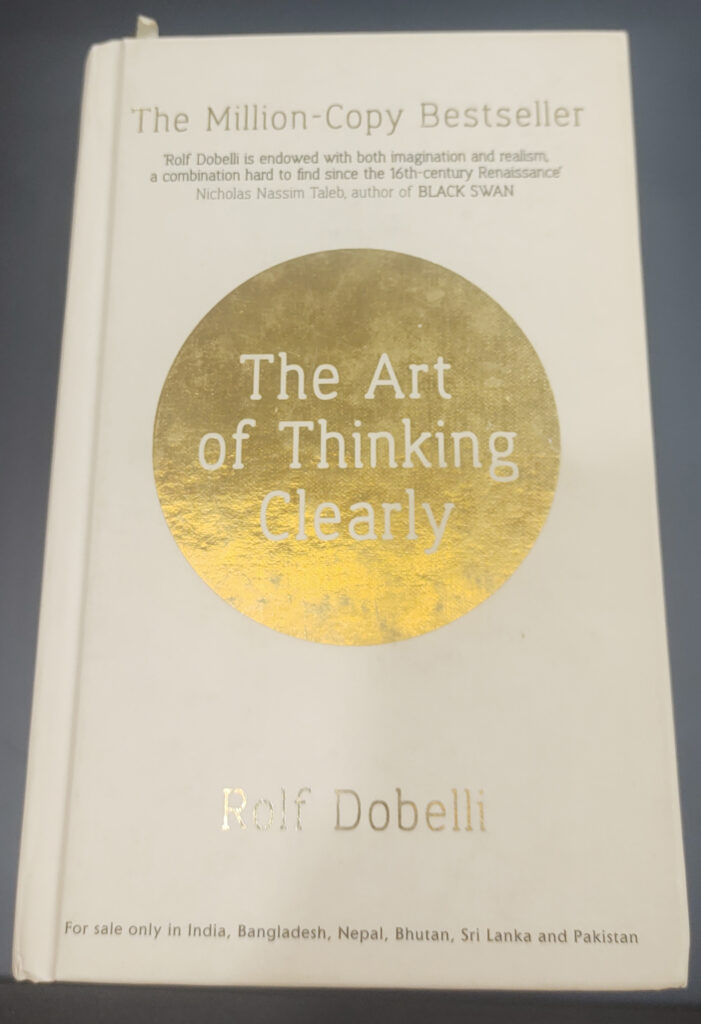The Art of Thinking Clearly is an agglomeration of 99 mental biases, illusions and fallacies. The inferences of deep psychological studies that will be too complicated for a layman to understand, is very beautifully explained by Rolf Dobelli in his book with the help of simple instances and examples.
In his Million-Copy bestseller, Rolf explains why it is important to know the psychology of human brain and what goes through it when it is time to make a decision. He also explains the roots of human behaviour, which is deeply influenced by the way our ancestors thought and lived in the paleolithic era. Because of this ability of our brain to think on its own, many times we intend to make decisions which we should make. Rolf explains 99 such factors which may influence our decision making. He makes us see the truth, how it actually is, rather than how our brain perceives it.

If you concentrate on one chapter a day, you might be able to see things with a different point of view for the day. You might not make some decisions you would have usually made. But if you have a great memory, and remember multiple chapters of the book at once, it is quite possible that you might not make any decision at all. You will be too unsure if you are making the right decision or not. Ironically, In the 90th Chapter of the book, named “Where is the off switch” Rolf discusses how overthinking can also lead to wrong decisions, in which case, you should go with your gut feeling. The book even has a chapter about Decision Fatigue, which explains how making decisions is an exhausting task, an ability which with time, diminishes and must be replenished by relaxing.
With all the information provided in the book to assist you to make the right decisions, it might get a bit confusing. But nevertheless, all the chapters given in the book made absolute sense. Especially the factors that are very common, but we easily miss when the time comes to make the right decision. For example, ‘if 50 million people say something foolish’, you may tend to believe that you are wrong and they are right. If somebody offers you a free drink and you accept it, and then they ask for a favor, you feel bound to accept because of the free drink. We always tend to give in to a limited period offer in the fear of missing out. When we have more choices, it gets more difficult to decide (Ironic, right?). In today’s world, we need to keep on doing something, to keep ourself engaged, just to create an illusion that we are being productive. We always feel sadder about what we don’t have than we feel happy about what we have. We live with this illusion of control but we often find ourself drooling whenever a new I-phone is launched. We almost never keep up with our new year resolutions. We always fall for sad stories. And don’t we all sometimes tend to volunteer just to feel happy about ourselves rather than to contribute to the actual cause? These and many more justifications are provided in the book in the form of very concise chapters, each addressing a different issue.
Aren’t all these factors mentioned above sound very relatable? Often, we are aware of what is wrong and what is right for us, but we still give in to our brain’s evil intentions. Now probably you understand why I mentioned (jokingly) that this book might lead you to make no decisions at all.
Conclusion
Overall, it is a very good read, although, you might find it a bit long because of the lack of continuation between chapters. Nevertheless, it has exciting chapter titles consisting of really apt real-life examples, backed up by years of research. Each chapter precisely explains why we tend to fall for all these biases, illusions and fallacies and what we should do in such situations to think clearly and come to the right decision. I would definitely suggest anyone and everyone to give it a try. Probably after some time, I will give it another go myself.